Health and Social Care: Working in Partnership Analysis Report
VerifiedAdded on 2020/07/23
|13
|4037
|111
Report
AI Summary
This report provides a comprehensive analysis of working in partnership within the health and social care sector. It begins by exploring the philosophies underpinning collaborative working, including empowerment, independence, autonomy, respect, and power sharing. The report then examines partnership relationships at different levels: with service users, with other professionals, and at an organizational level, highlighting potential barriers such as increased complexity and conflicting objectives. Task 2 delves into various models of partnership, such as formal and informal partnerships, joint funding, and networking, and discusses current legislations in the UK that guide and regulate these partnerships to protect service users' rights and ensure ethical practices. The report also discusses potential outcomes of partnerships, including improved service delivery and patient satisfaction, as well as potential barriers to effective collaboration and strategies to enhance partnership outcomes, such as clear communication and shared decision-making. The report emphasizes the importance of integrated systems, shared resources, and mutual respect to deliver efficient and effective health and social care services.

WORKING IN
PARTNERSHIP
PARTNERSHIP
Paraphrase This Document
Need a fresh take? Get an instant paraphrase of this document with our AI Paraphraser
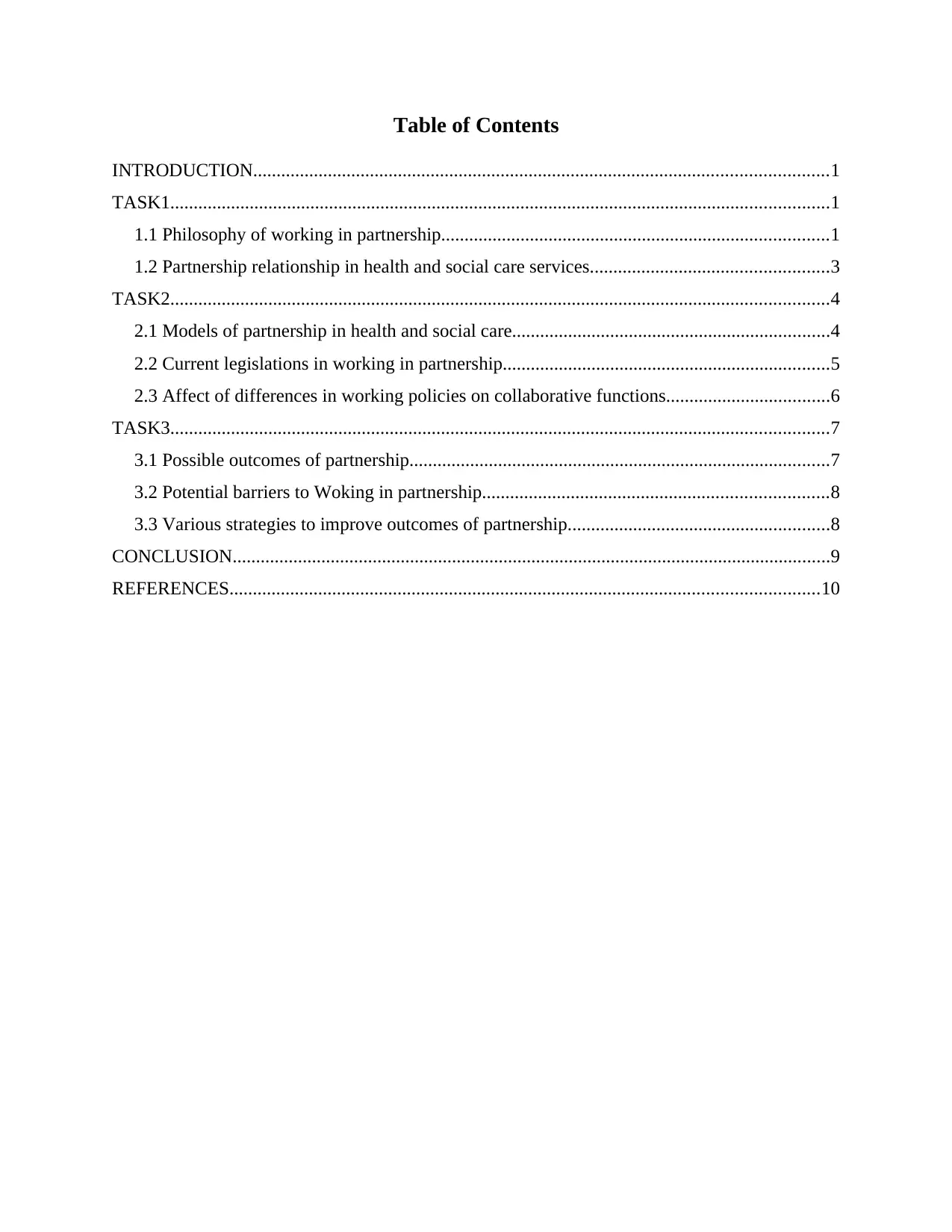
Table of Contents
INTRODUCTION...........................................................................................................................1
TASK1.............................................................................................................................................1
1.1 Philosophy of working in partnership...................................................................................1
1.2 Partnership relationship in health and social care services...................................................3
TASK2.............................................................................................................................................4
2.1 Models of partnership in health and social care....................................................................4
2.2 Current legislations in working in partnership......................................................................5
2.3 Affect of differences in working policies on collaborative functions...................................6
TASK3.............................................................................................................................................7
3.1 Possible outcomes of partnership..........................................................................................7
3.2 Potential barriers to Woking in partnership..........................................................................8
3.3 Various strategies to improve outcomes of partnership........................................................8
CONCLUSION................................................................................................................................9
REFERENCES..............................................................................................................................10
INTRODUCTION...........................................................................................................................1
TASK1.............................................................................................................................................1
1.1 Philosophy of working in partnership...................................................................................1
1.2 Partnership relationship in health and social care services...................................................3
TASK2.............................................................................................................................................4
2.1 Models of partnership in health and social care....................................................................4
2.2 Current legislations in working in partnership......................................................................5
2.3 Affect of differences in working policies on collaborative functions...................................6
TASK3.............................................................................................................................................7
3.1 Possible outcomes of partnership..........................................................................................7
3.2 Potential barriers to Woking in partnership..........................................................................8
3.3 Various strategies to improve outcomes of partnership........................................................8
CONCLUSION................................................................................................................................9
REFERENCES..............................................................................................................................10

⊘ This is a preview!⊘
Do you want full access?
Subscribe today to unlock all pages.

Trusted by 1+ million students worldwide
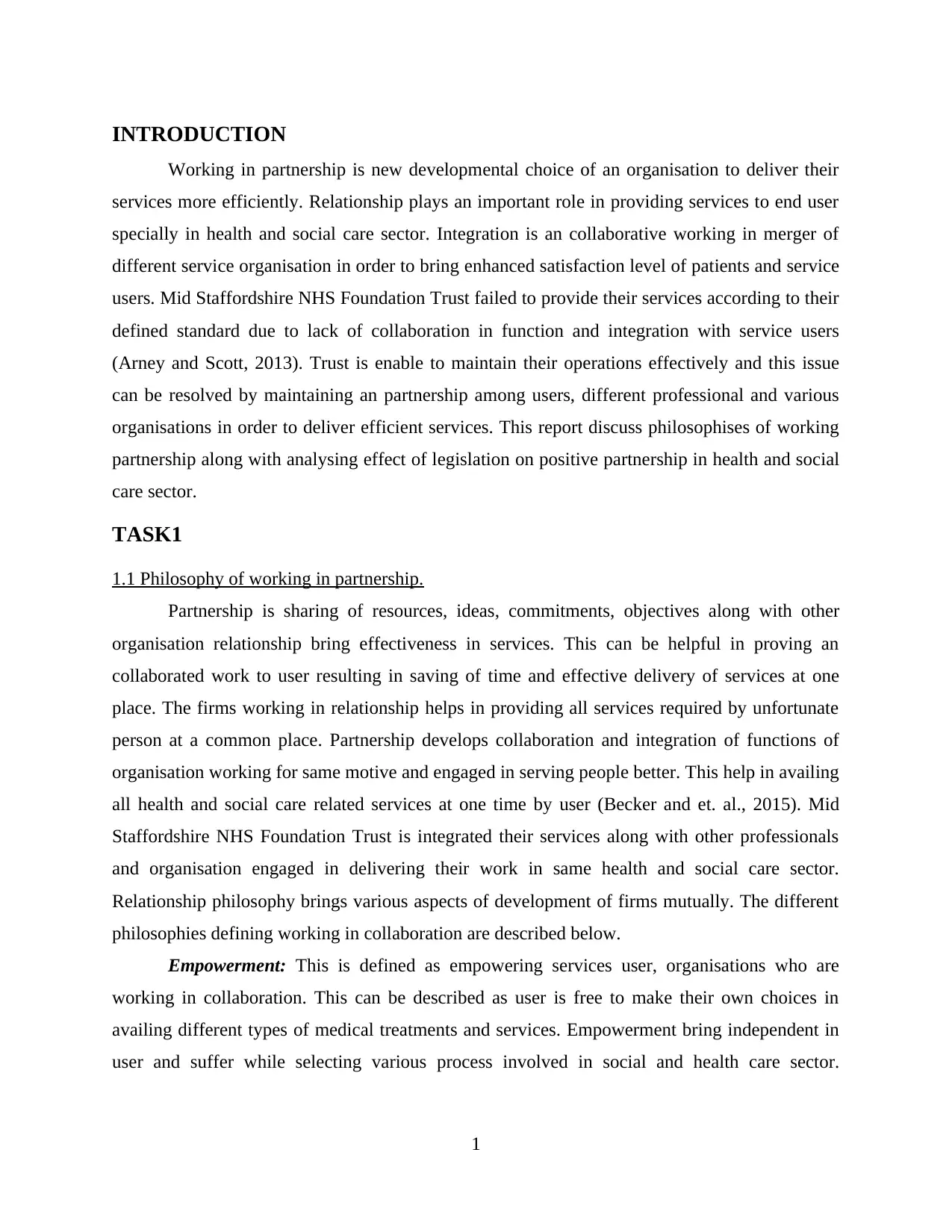
INTRODUCTION
Working in partnership is new developmental choice of an organisation to deliver their
services more efficiently. Relationship plays an important role in providing services to end user
specially in health and social care sector. Integration is an collaborative working in merger of
different service organisation in order to bring enhanced satisfaction level of patients and service
users. Mid Staffordshire NHS Foundation Trust failed to provide their services according to their
defined standard due to lack of collaboration in function and integration with service users
(Arney and Scott, 2013). Trust is enable to maintain their operations effectively and this issue
can be resolved by maintaining an partnership among users, different professional and various
organisations in order to deliver efficient services. This report discuss philosophises of working
partnership along with analysing effect of legislation on positive partnership in health and social
care sector.
TASK1
1.1 Philosophy of working in partnership.
Partnership is sharing of resources, ideas, commitments, objectives along with other
organisation relationship bring effectiveness in services. This can be helpful in proving an
collaborated work to user resulting in saving of time and effective delivery of services at one
place. The firms working in relationship helps in providing all services required by unfortunate
person at a common place. Partnership develops collaboration and integration of functions of
organisation working for same motive and engaged in serving people better. This help in availing
all health and social care related services at one time by user (Becker and et. al., 2015). Mid
Staffordshire NHS Foundation Trust is integrated their services along with other professionals
and organisation engaged in delivering their work in same health and social care sector.
Relationship philosophy brings various aspects of development of firms mutually. The different
philosophies defining working in collaboration are described below.
Empowerment: This is defined as empowering services user, organisations who are
working in collaboration. This can be described as user is free to make their own choices in
availing different types of medical treatments and services. Empowerment bring independent in
user and suffer while selecting various process involved in social and health care sector.
1
Working in partnership is new developmental choice of an organisation to deliver their
services more efficiently. Relationship plays an important role in providing services to end user
specially in health and social care sector. Integration is an collaborative working in merger of
different service organisation in order to bring enhanced satisfaction level of patients and service
users. Mid Staffordshire NHS Foundation Trust failed to provide their services according to their
defined standard due to lack of collaboration in function and integration with service users
(Arney and Scott, 2013). Trust is enable to maintain their operations effectively and this issue
can be resolved by maintaining an partnership among users, different professional and various
organisations in order to deliver efficient services. This report discuss philosophises of working
partnership along with analysing effect of legislation on positive partnership in health and social
care sector.
TASK1
1.1 Philosophy of working in partnership.
Partnership is sharing of resources, ideas, commitments, objectives along with other
organisation relationship bring effectiveness in services. This can be helpful in proving an
collaborated work to user resulting in saving of time and effective delivery of services at one
place. The firms working in relationship helps in providing all services required by unfortunate
person at a common place. Partnership develops collaboration and integration of functions of
organisation working for same motive and engaged in serving people better. This help in availing
all health and social care related services at one time by user (Becker and et. al., 2015). Mid
Staffordshire NHS Foundation Trust is integrated their services along with other professionals
and organisation engaged in delivering their work in same health and social care sector.
Relationship philosophy brings various aspects of development of firms mutually. The different
philosophies defining working in collaboration are described below.
Empowerment: This is defined as empowering services user, organisations who are
working in collaboration. This can be described as user is free to make their own choices in
availing different types of medical treatments and services. Empowerment bring independent in
user and suffer while selecting various process involved in social and health care sector.
1
Paraphrase This Document
Need a fresh take? Get an instant paraphrase of this document with our AI Paraphraser
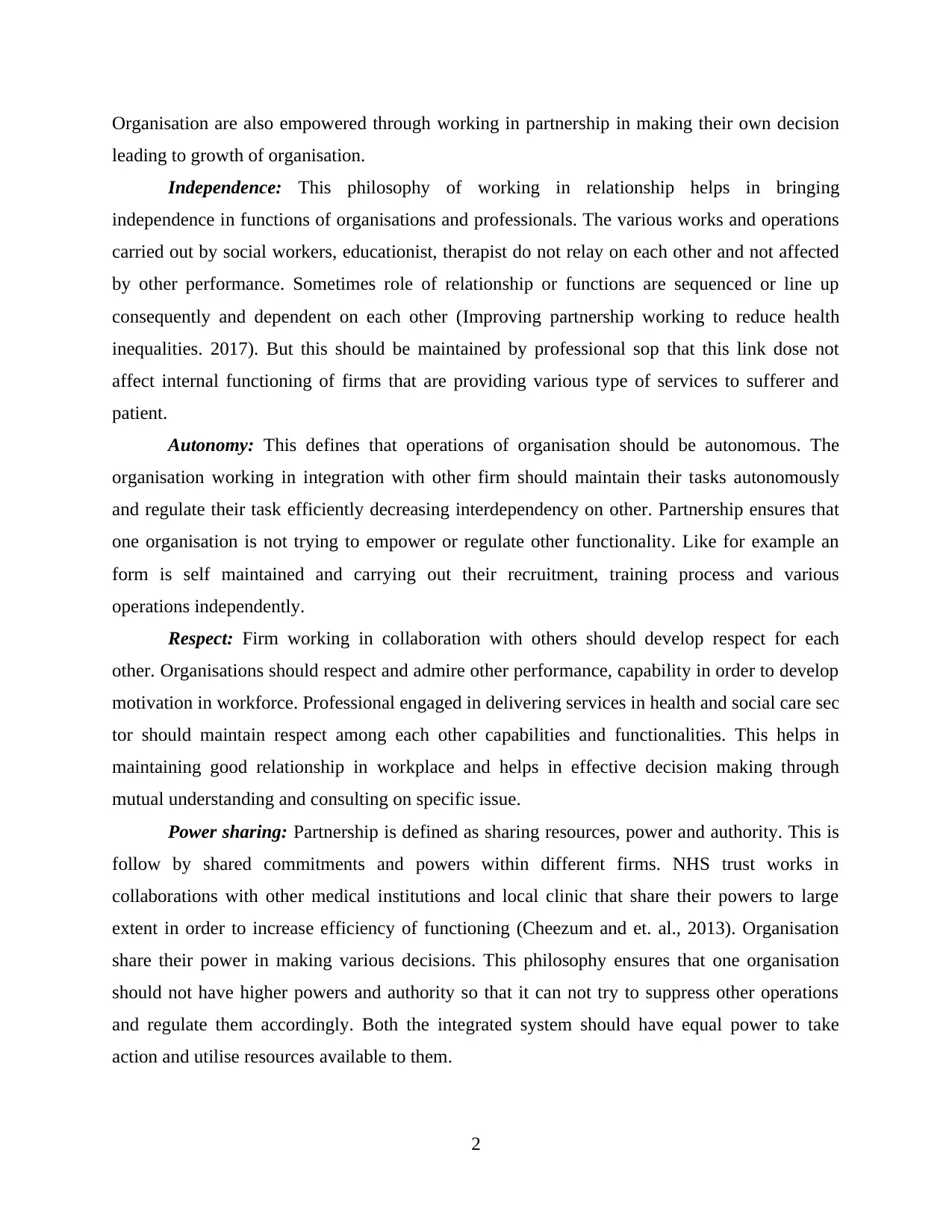
Organisation are also empowered through working in partnership in making their own decision
leading to growth of organisation.
Independence: This philosophy of working in relationship helps in bringing
independence in functions of organisations and professionals. The various works and operations
carried out by social workers, educationist, therapist do not relay on each other and not affected
by other performance. Sometimes role of relationship or functions are sequenced or line up
consequently and dependent on each other (Improving partnership working to reduce health
inequalities. 2017). But this should be maintained by professional sop that this link dose not
affect internal functioning of firms that are providing various type of services to sufferer and
patient.
Autonomy: This defines that operations of organisation should be autonomous. The
organisation working in integration with other firm should maintain their tasks autonomously
and regulate their task efficiently decreasing interdependency on other. Partnership ensures that
one organisation is not trying to empower or regulate other functionality. Like for example an
form is self maintained and carrying out their recruitment, training process and various
operations independently.
Respect: Firm working in collaboration with others should develop respect for each
other. Organisations should respect and admire other performance, capability in order to develop
motivation in workforce. Professional engaged in delivering services in health and social care sec
tor should maintain respect among each other capabilities and functionalities. This helps in
maintaining good relationship in workplace and helps in effective decision making through
mutual understanding and consulting on specific issue.
Power sharing: Partnership is defined as sharing resources, power and authority. This is
follow by shared commitments and powers within different firms. NHS trust works in
collaborations with other medical institutions and local clinic that share their powers to large
extent in order to increase efficiency of functioning (Cheezum and et. al., 2013). Organisation
share their power in making various decisions. This philosophy ensures that one organisation
should not have higher powers and authority so that it can not try to suppress other operations
and regulate them accordingly. Both the integrated system should have equal power to take
action and utilise resources available to them.
2
leading to growth of organisation.
Independence: This philosophy of working in relationship helps in bringing
independence in functions of organisations and professionals. The various works and operations
carried out by social workers, educationist, therapist do not relay on each other and not affected
by other performance. Sometimes role of relationship or functions are sequenced or line up
consequently and dependent on each other (Improving partnership working to reduce health
inequalities. 2017). But this should be maintained by professional sop that this link dose not
affect internal functioning of firms that are providing various type of services to sufferer and
patient.
Autonomy: This defines that operations of organisation should be autonomous. The
organisation working in integration with other firm should maintain their tasks autonomously
and regulate their task efficiently decreasing interdependency on other. Partnership ensures that
one organisation is not trying to empower or regulate other functionality. Like for example an
form is self maintained and carrying out their recruitment, training process and various
operations independently.
Respect: Firm working in collaboration with others should develop respect for each
other. Organisations should respect and admire other performance, capability in order to develop
motivation in workforce. Professional engaged in delivering services in health and social care sec
tor should maintain respect among each other capabilities and functionalities. This helps in
maintaining good relationship in workplace and helps in effective decision making through
mutual understanding and consulting on specific issue.
Power sharing: Partnership is defined as sharing resources, power and authority. This is
follow by shared commitments and powers within different firms. NHS trust works in
collaborations with other medical institutions and local clinic that share their powers to large
extent in order to increase efficiency of functioning (Cheezum and et. al., 2013). Organisation
share their power in making various decisions. This philosophy ensures that one organisation
should not have higher powers and authority so that it can not try to suppress other operations
and regulate them accordingly. Both the integrated system should have equal power to take
action and utilise resources available to them.
2
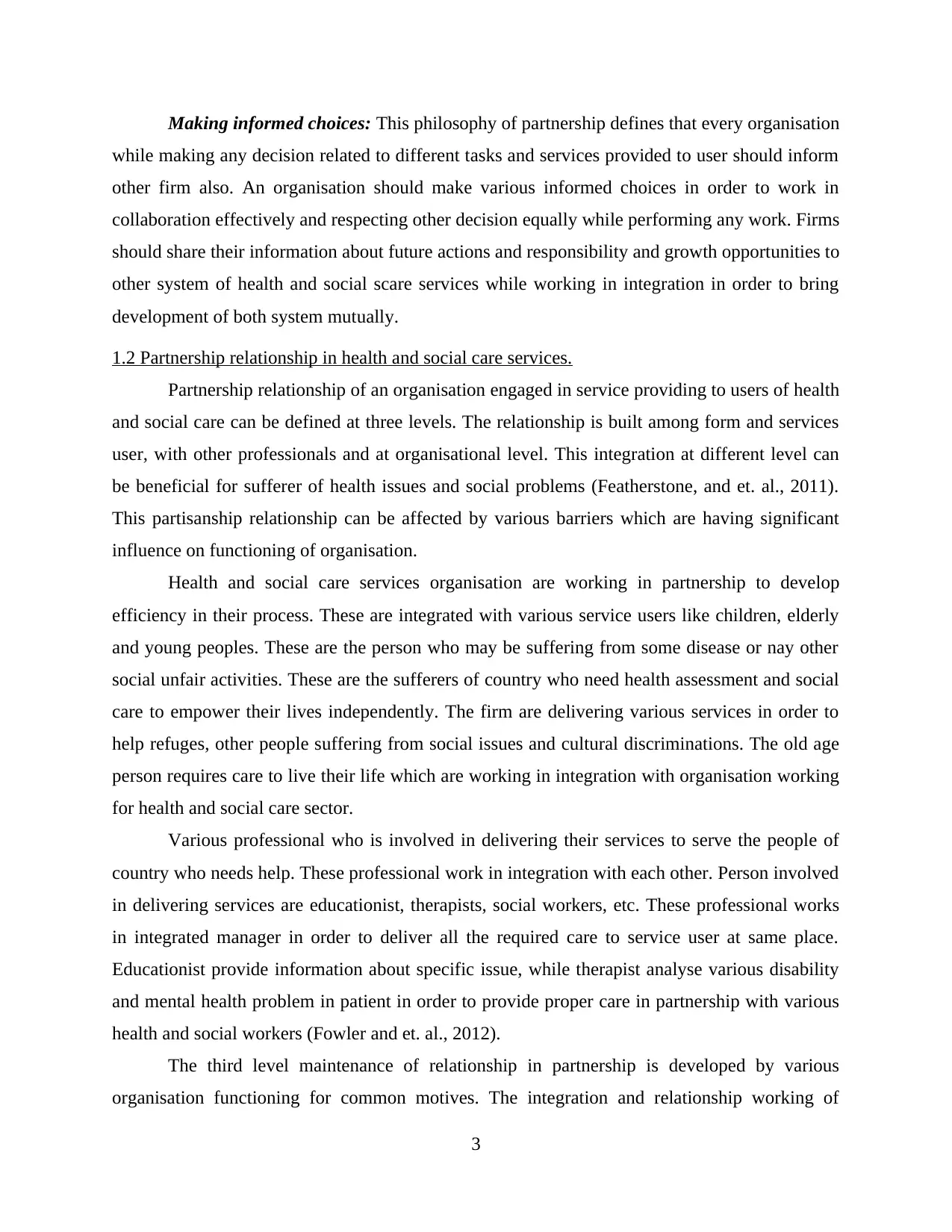
Making informed choices: This philosophy of partnership defines that every organisation
while making any decision related to different tasks and services provided to user should inform
other firm also. An organisation should make various informed choices in order to work in
collaboration effectively and respecting other decision equally while performing any work. Firms
should share their information about future actions and responsibility and growth opportunities to
other system of health and social scare services while working in integration in order to bring
development of both system mutually.
1.2 Partnership relationship in health and social care services.
Partnership relationship of an organisation engaged in service providing to users of health
and social care can be defined at three levels. The relationship is built among form and services
user, with other professionals and at organisational level. This integration at different level can
be beneficial for sufferer of health issues and social problems (Featherstone, and et. al., 2011).
This partisanship relationship can be affected by various barriers which are having significant
influence on functioning of organisation.
Health and social care services organisation are working in partnership to develop
efficiency in their process. These are integrated with various service users like children, elderly
and young peoples. These are the person who may be suffering from some disease or nay other
social unfair activities. These are the sufferers of country who need health assessment and social
care to empower their lives independently. The firm are delivering various services in order to
help refuges, other people suffering from social issues and cultural discriminations. The old age
person requires care to live their life which are working in integration with organisation working
for health and social care sector.
Various professional who is involved in delivering their services to serve the people of
country who needs help. These professional work in integration with each other. Person involved
in delivering services are educationist, therapists, social workers, etc. These professional works
in integrated manager in order to deliver all the required care to service user at same place.
Educationist provide information about specific issue, while therapist analyse various disability
and mental health problem in patient in order to provide proper care in partnership with various
health and social workers (Fowler and et. al., 2012).
The third level maintenance of relationship in partnership is developed by various
organisation functioning for common motives. The integration and relationship working of
3
while making any decision related to different tasks and services provided to user should inform
other firm also. An organisation should make various informed choices in order to work in
collaboration effectively and respecting other decision equally while performing any work. Firms
should share their information about future actions and responsibility and growth opportunities to
other system of health and social scare services while working in integration in order to bring
development of both system mutually.
1.2 Partnership relationship in health and social care services.
Partnership relationship of an organisation engaged in service providing to users of health
and social care can be defined at three levels. The relationship is built among form and services
user, with other professionals and at organisational level. This integration at different level can
be beneficial for sufferer of health issues and social problems (Featherstone, and et. al., 2011).
This partisanship relationship can be affected by various barriers which are having significant
influence on functioning of organisation.
Health and social care services organisation are working in partnership to develop
efficiency in their process. These are integrated with various service users like children, elderly
and young peoples. These are the person who may be suffering from some disease or nay other
social unfair activities. These are the sufferers of country who need health assessment and social
care to empower their lives independently. The firm are delivering various services in order to
help refuges, other people suffering from social issues and cultural discriminations. The old age
person requires care to live their life which are working in integration with organisation working
for health and social care sector.
Various professional who is involved in delivering their services to serve the people of
country who needs help. These professional work in integration with each other. Person involved
in delivering services are educationist, therapists, social workers, etc. These professional works
in integrated manager in order to deliver all the required care to service user at same place.
Educationist provide information about specific issue, while therapist analyse various disability
and mental health problem in patient in order to provide proper care in partnership with various
health and social workers (Fowler and et. al., 2012).
The third level maintenance of relationship in partnership is developed by various
organisation functioning for common motives. The integration and relationship working of
3
⊘ This is a preview!⊘
Do you want full access?
Subscribe today to unlock all pages.

Trusted by 1+ million students worldwide
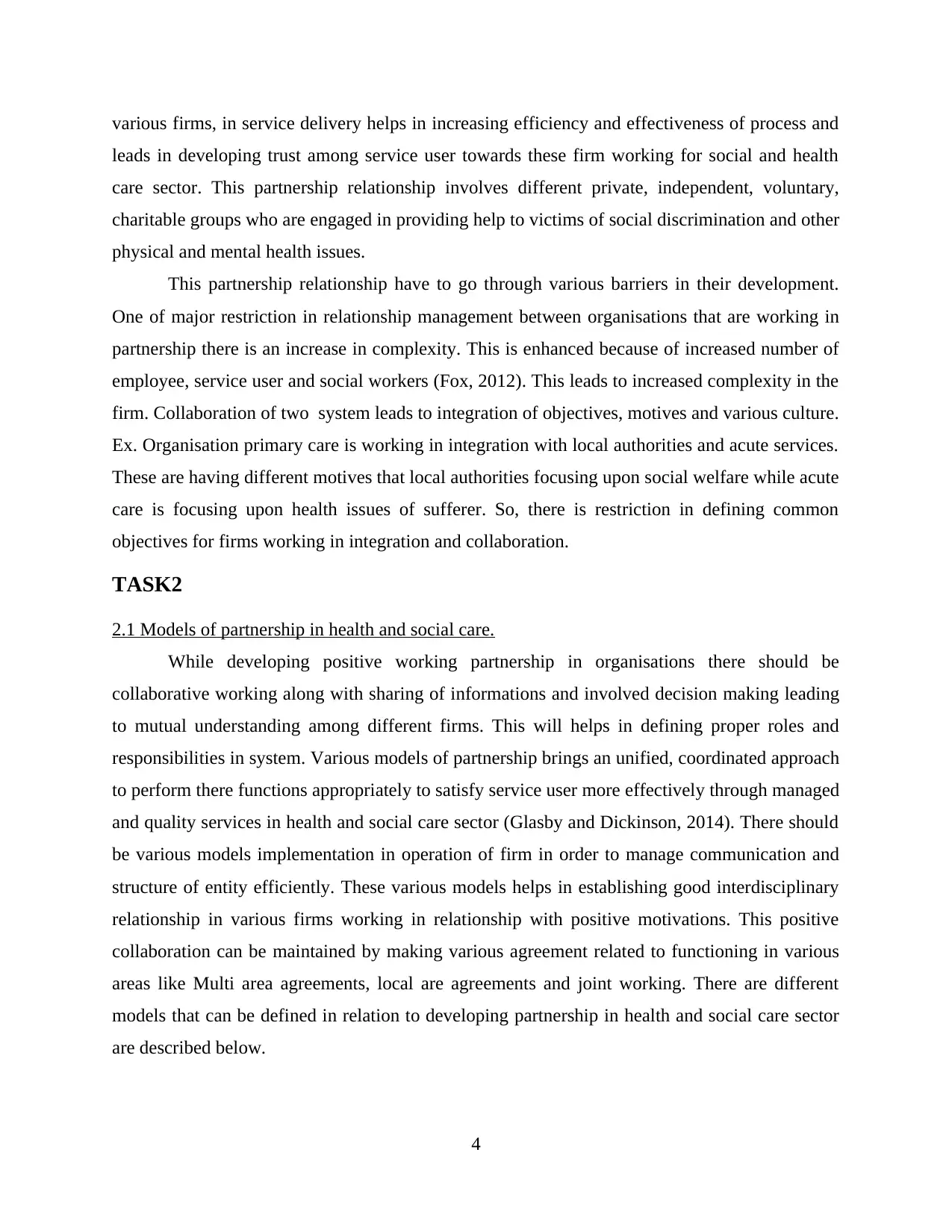
various firms, in service delivery helps in increasing efficiency and effectiveness of process and
leads in developing trust among service user towards these firm working for social and health
care sector. This partnership relationship involves different private, independent, voluntary,
charitable groups who are engaged in providing help to victims of social discrimination and other
physical and mental health issues.
This partnership relationship have to go through various barriers in their development.
One of major restriction in relationship management between organisations that are working in
partnership there is an increase in complexity. This is enhanced because of increased number of
employee, service user and social workers (Fox, 2012). This leads to increased complexity in the
firm. Collaboration of two system leads to integration of objectives, motives and various culture.
Ex. Organisation primary care is working in integration with local authorities and acute services.
These are having different motives that local authorities focusing upon social welfare while acute
care is focusing upon health issues of sufferer. So, there is restriction in defining common
objectives for firms working in integration and collaboration.
TASK2
2.1 Models of partnership in health and social care.
While developing positive working partnership in organisations there should be
collaborative working along with sharing of informations and involved decision making leading
to mutual understanding among different firms. This will helps in defining proper roles and
responsibilities in system. Various models of partnership brings an unified, coordinated approach
to perform there functions appropriately to satisfy service user more effectively through managed
and quality services in health and social care sector (Glasby and Dickinson, 2014). There should
be various models implementation in operation of firm in order to manage communication and
structure of entity efficiently. These various models helps in establishing good interdisciplinary
relationship in various firms working in relationship with positive motivations. This positive
collaboration can be maintained by making various agreement related to functioning in various
areas like Multi area agreements, local are agreements and joint working. There are different
models that can be defined in relation to developing partnership in health and social care sector
are described below.
4
leads in developing trust among service user towards these firm working for social and health
care sector. This partnership relationship involves different private, independent, voluntary,
charitable groups who are engaged in providing help to victims of social discrimination and other
physical and mental health issues.
This partnership relationship have to go through various barriers in their development.
One of major restriction in relationship management between organisations that are working in
partnership there is an increase in complexity. This is enhanced because of increased number of
employee, service user and social workers (Fox, 2012). This leads to increased complexity in the
firm. Collaboration of two system leads to integration of objectives, motives and various culture.
Ex. Organisation primary care is working in integration with local authorities and acute services.
These are having different motives that local authorities focusing upon social welfare while acute
care is focusing upon health issues of sufferer. So, there is restriction in defining common
objectives for firms working in integration and collaboration.
TASK2
2.1 Models of partnership in health and social care.
While developing positive working partnership in organisations there should be
collaborative working along with sharing of informations and involved decision making leading
to mutual understanding among different firms. This will helps in defining proper roles and
responsibilities in system. Various models of partnership brings an unified, coordinated approach
to perform there functions appropriately to satisfy service user more effectively through managed
and quality services in health and social care sector (Glasby and Dickinson, 2014). There should
be various models implementation in operation of firm in order to manage communication and
structure of entity efficiently. These various models helps in establishing good interdisciplinary
relationship in various firms working in relationship with positive motivations. This positive
collaboration can be maintained by making various agreement related to functioning in various
areas like Multi area agreements, local are agreements and joint working. There are different
models that can be defined in relation to developing partnership in health and social care sector
are described below.
4
Paraphrase This Document
Need a fresh take? Get an instant paraphrase of this document with our AI Paraphraser
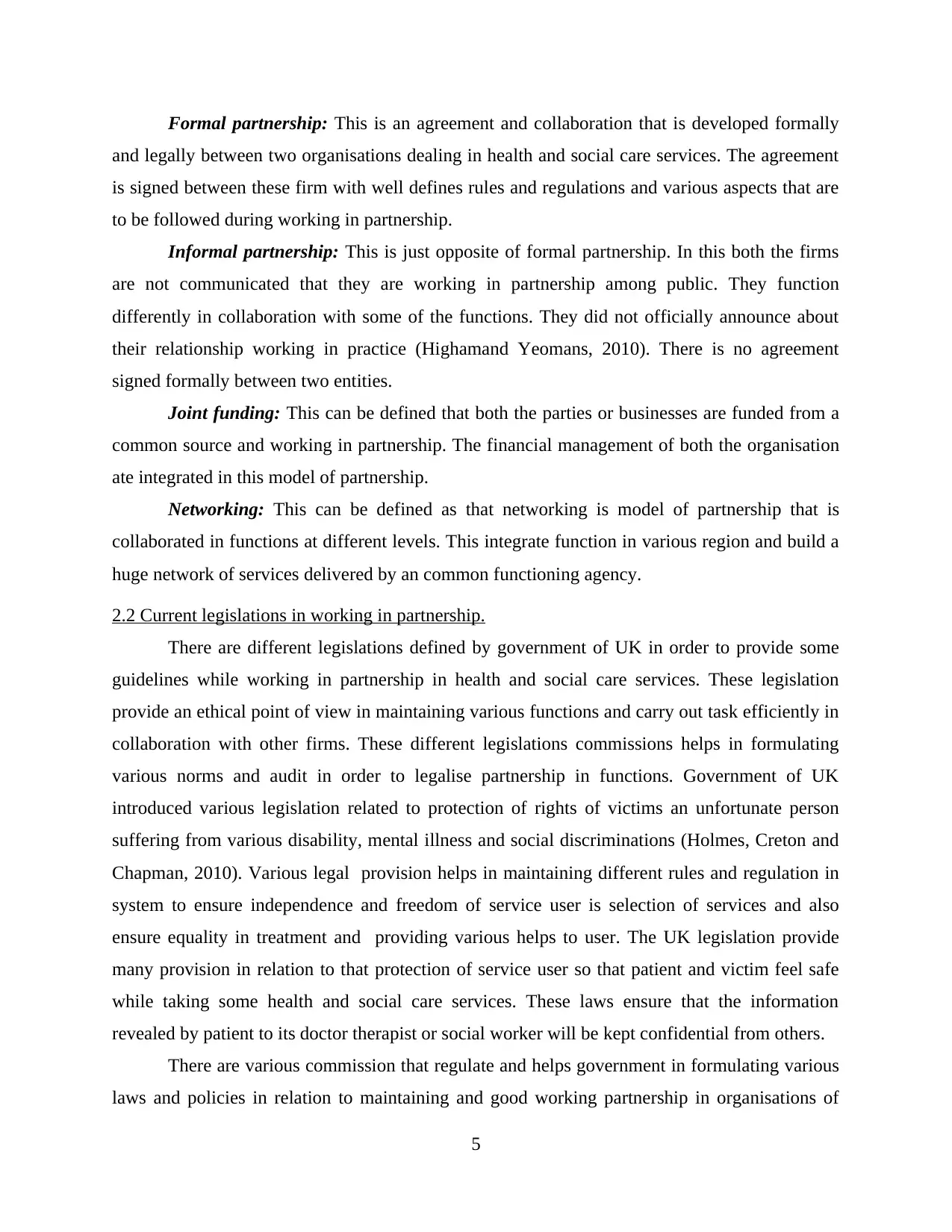
Formal partnership: This is an agreement and collaboration that is developed formally
and legally between two organisations dealing in health and social care services. The agreement
is signed between these firm with well defines rules and regulations and various aspects that are
to be followed during working in partnership.
Informal partnership: This is just opposite of formal partnership. In this both the firms
are not communicated that they are working in partnership among public. They function
differently in collaboration with some of the functions. They did not officially announce about
their relationship working in practice (Highamand Yeomans, 2010). There is no agreement
signed formally between two entities.
Joint funding: This can be defined that both the parties or businesses are funded from a
common source and working in partnership. The financial management of both the organisation
ate integrated in this model of partnership.
Networking: This can be defined as that networking is model of partnership that is
collaborated in functions at different levels. This integrate function in various region and build a
huge network of services delivered by an common functioning agency.
2.2 Current legislations in working in partnership.
There are different legislations defined by government of UK in order to provide some
guidelines while working in partnership in health and social care services. These legislation
provide an ethical point of view in maintaining various functions and carry out task efficiently in
collaboration with other firms. These different legislations commissions helps in formulating
various norms and audit in order to legalise partnership in functions. Government of UK
introduced various legislation related to protection of rights of victims an unfortunate person
suffering from various disability, mental illness and social discriminations (Holmes, Creton and
Chapman, 2010). Various legal provision helps in maintaining different rules and regulation in
system to ensure independence and freedom of service user is selection of services and also
ensure equality in treatment and providing various helps to user. The UK legislation provide
many provision in relation to that protection of service user so that patient and victim feel safe
while taking some health and social care services. These laws ensure that the information
revealed by patient to its doctor therapist or social worker will be kept confidential from others.
There are various commission that regulate and helps government in formulating various
laws and policies in relation to maintaining and good working partnership in organisations of
5
and legally between two organisations dealing in health and social care services. The agreement
is signed between these firm with well defines rules and regulations and various aspects that are
to be followed during working in partnership.
Informal partnership: This is just opposite of formal partnership. In this both the firms
are not communicated that they are working in partnership among public. They function
differently in collaboration with some of the functions. They did not officially announce about
their relationship working in practice (Highamand Yeomans, 2010). There is no agreement
signed formally between two entities.
Joint funding: This can be defined that both the parties or businesses are funded from a
common source and working in partnership. The financial management of both the organisation
ate integrated in this model of partnership.
Networking: This can be defined as that networking is model of partnership that is
collaborated in functions at different levels. This integrate function in various region and build a
huge network of services delivered by an common functioning agency.
2.2 Current legislations in working in partnership.
There are different legislations defined by government of UK in order to provide some
guidelines while working in partnership in health and social care services. These legislation
provide an ethical point of view in maintaining various functions and carry out task efficiently in
collaboration with other firms. These different legislations commissions helps in formulating
various norms and audit in order to legalise partnership in functions. Government of UK
introduced various legislation related to protection of rights of victims an unfortunate person
suffering from various disability, mental illness and social discriminations (Holmes, Creton and
Chapman, 2010). Various legal provision helps in maintaining different rules and regulation in
system to ensure independence and freedom of service user is selection of services and also
ensure equality in treatment and providing various helps to user. The UK legislation provide
many provision in relation to that protection of service user so that patient and victim feel safe
while taking some health and social care services. These laws ensure that the information
revealed by patient to its doctor therapist or social worker will be kept confidential from others.
There are various commission that regulate and helps government in formulating various
laws and policies in relation to maintaining and good working partnership in organisations of
5
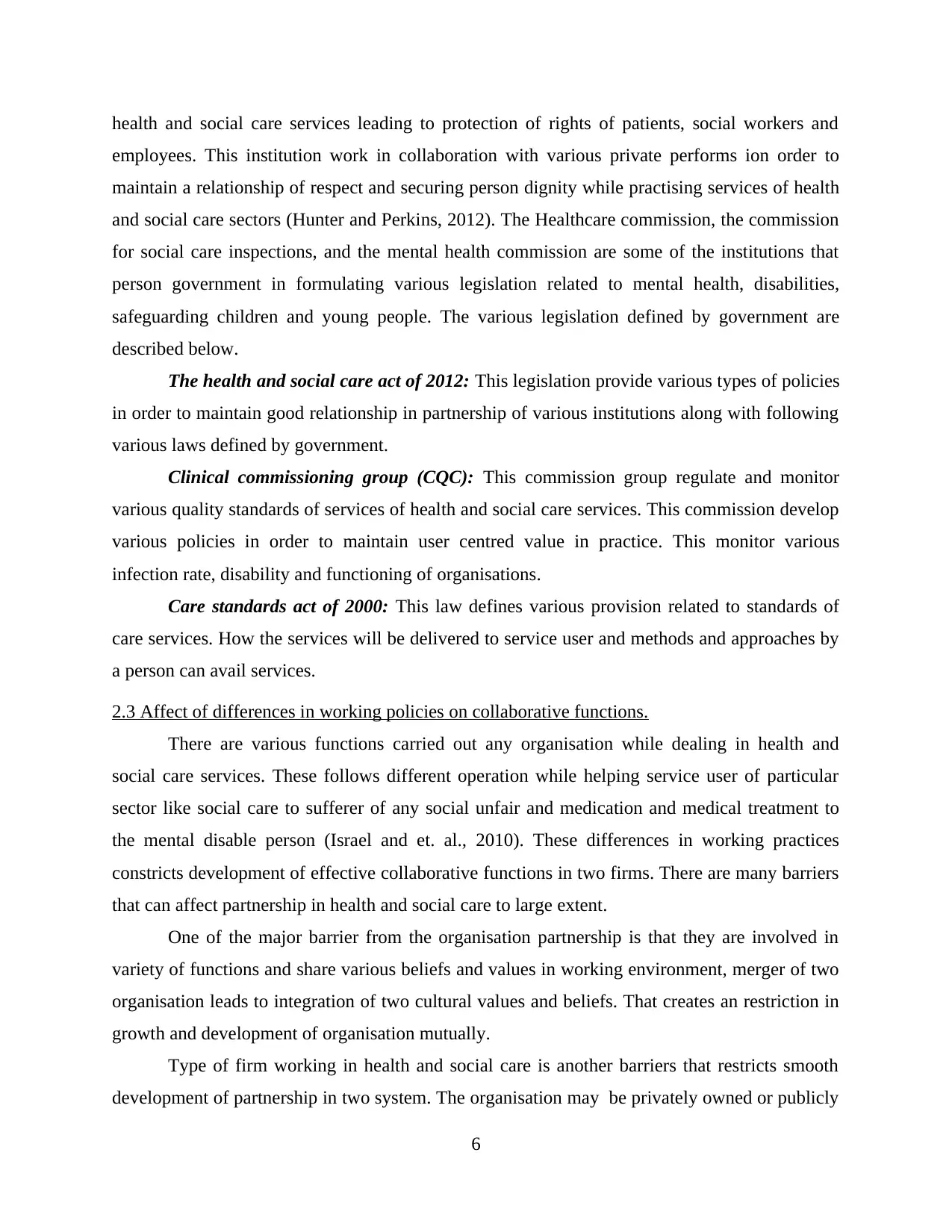
health and social care services leading to protection of rights of patients, social workers and
employees. This institution work in collaboration with various private performs ion order to
maintain a relationship of respect and securing person dignity while practising services of health
and social care sectors (Hunter and Perkins, 2012). The Healthcare commission, the commission
for social care inspections, and the mental health commission are some of the institutions that
person government in formulating various legislation related to mental health, disabilities,
safeguarding children and young people. The various legislation defined by government are
described below.
The health and social care act of 2012: This legislation provide various types of policies
in order to maintain good relationship in partnership of various institutions along with following
various laws defined by government.
Clinical commissioning group (CQC): This commission group regulate and monitor
various quality standards of services of health and social care services. This commission develop
various policies in order to maintain user centred value in practice. This monitor various
infection rate, disability and functioning of organisations.
Care standards act of 2000: This law defines various provision related to standards of
care services. How the services will be delivered to service user and methods and approaches by
a person can avail services.
2.3 Affect of differences in working policies on collaborative functions.
There are various functions carried out any organisation while dealing in health and
social care services. These follows different operation while helping service user of particular
sector like social care to sufferer of any social unfair and medication and medical treatment to
the mental disable person (Israel and et. al., 2010). These differences in working practices
constricts development of effective collaborative functions in two firms. There are many barriers
that can affect partnership in health and social care to large extent.
One of the major barrier from the organisation partnership is that they are involved in
variety of functions and share various beliefs and values in working environment, merger of two
organisation leads to integration of two cultural values and beliefs. That creates an restriction in
growth and development of organisation mutually.
Type of firm working in health and social care is another barriers that restricts smooth
development of partnership in two system. The organisation may be privately owned or publicly
6
employees. This institution work in collaboration with various private performs ion order to
maintain a relationship of respect and securing person dignity while practising services of health
and social care sectors (Hunter and Perkins, 2012). The Healthcare commission, the commission
for social care inspections, and the mental health commission are some of the institutions that
person government in formulating various legislation related to mental health, disabilities,
safeguarding children and young people. The various legislation defined by government are
described below.
The health and social care act of 2012: This legislation provide various types of policies
in order to maintain good relationship in partnership of various institutions along with following
various laws defined by government.
Clinical commissioning group (CQC): This commission group regulate and monitor
various quality standards of services of health and social care services. This commission develop
various policies in order to maintain user centred value in practice. This monitor various
infection rate, disability and functioning of organisations.
Care standards act of 2000: This law defines various provision related to standards of
care services. How the services will be delivered to service user and methods and approaches by
a person can avail services.
2.3 Affect of differences in working policies on collaborative functions.
There are various functions carried out any organisation while dealing in health and
social care services. These follows different operation while helping service user of particular
sector like social care to sufferer of any social unfair and medication and medical treatment to
the mental disable person (Israel and et. al., 2010). These differences in working practices
constricts development of effective collaborative functions in two firms. There are many barriers
that can affect partnership in health and social care to large extent.
One of the major barrier from the organisation partnership is that they are involved in
variety of functions and share various beliefs and values in working environment, merger of two
organisation leads to integration of two cultural values and beliefs. That creates an restriction in
growth and development of organisation mutually.
Type of firm working in health and social care is another barriers that restricts smooth
development of partnership in two system. The organisation may be privately owned or publicly
6
⊘ This is a preview!⊘
Do you want full access?
Subscribe today to unlock all pages.

Trusted by 1+ million students worldwide
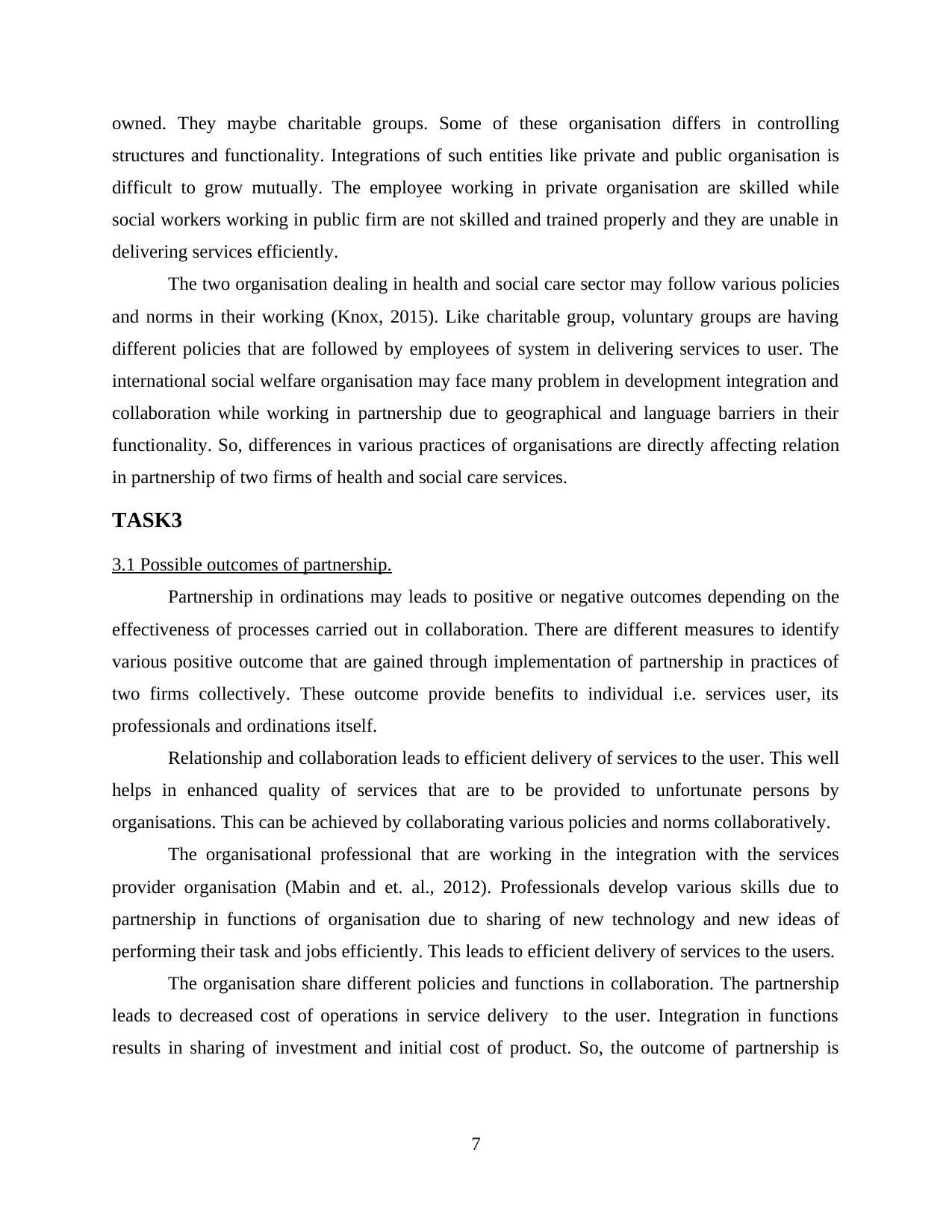
owned. They maybe charitable groups. Some of these organisation differs in controlling
structures and functionality. Integrations of such entities like private and public organisation is
difficult to grow mutually. The employee working in private organisation are skilled while
social workers working in public firm are not skilled and trained properly and they are unable in
delivering services efficiently.
The two organisation dealing in health and social care sector may follow various policies
and norms in their working (Knox, 2015). Like charitable group, voluntary groups are having
different policies that are followed by employees of system in delivering services to user. The
international social welfare organisation may face many problem in development integration and
collaboration while working in partnership due to geographical and language barriers in their
functionality. So, differences in various practices of organisations are directly affecting relation
in partnership of two firms of health and social care services.
TASK3
3.1 Possible outcomes of partnership.
Partnership in ordinations may leads to positive or negative outcomes depending on the
effectiveness of processes carried out in collaboration. There are different measures to identify
various positive outcome that are gained through implementation of partnership in practices of
two firms collectively. These outcome provide benefits to individual i.e. services user, its
professionals and ordinations itself.
Relationship and collaboration leads to efficient delivery of services to the user. This well
helps in enhanced quality of services that are to be provided to unfortunate persons by
organisations. This can be achieved by collaborating various policies and norms collaboratively.
The organisational professional that are working in the integration with the services
provider organisation (Mabin and et. al., 2012). Professionals develop various skills due to
partnership in functions of organisation due to sharing of new technology and new ideas of
performing their task and jobs efficiently. This leads to efficient delivery of services to the users.
The organisation share different policies and functions in collaboration. The partnership
leads to decreased cost of operations in service delivery to the user. Integration in functions
results in sharing of investment and initial cost of product. So, the outcome of partnership is
7
structures and functionality. Integrations of such entities like private and public organisation is
difficult to grow mutually. The employee working in private organisation are skilled while
social workers working in public firm are not skilled and trained properly and they are unable in
delivering services efficiently.
The two organisation dealing in health and social care sector may follow various policies
and norms in their working (Knox, 2015). Like charitable group, voluntary groups are having
different policies that are followed by employees of system in delivering services to user. The
international social welfare organisation may face many problem in development integration and
collaboration while working in partnership due to geographical and language barriers in their
functionality. So, differences in various practices of organisations are directly affecting relation
in partnership of two firms of health and social care services.
TASK3
3.1 Possible outcomes of partnership.
Partnership in ordinations may leads to positive or negative outcomes depending on the
effectiveness of processes carried out in collaboration. There are different measures to identify
various positive outcome that are gained through implementation of partnership in practices of
two firms collectively. These outcome provide benefits to individual i.e. services user, its
professionals and ordinations itself.
Relationship and collaboration leads to efficient delivery of services to the user. This well
helps in enhanced quality of services that are to be provided to unfortunate persons by
organisations. This can be achieved by collaborating various policies and norms collaboratively.
The organisational professional that are working in the integration with the services
provider organisation (Mabin and et. al., 2012). Professionals develop various skills due to
partnership in functions of organisation due to sharing of new technology and new ideas of
performing their task and jobs efficiently. This leads to efficient delivery of services to the users.
The organisation share different policies and functions in collaboration. The partnership
leads to decreased cost of operations in service delivery to the user. Integration in functions
results in sharing of investment and initial cost of product. So, the outcome of partnership is
7
Paraphrase This Document
Need a fresh take? Get an instant paraphrase of this document with our AI Paraphraser

positive if the organisation work in integrated manner by defining standards of performance and
works efficiently by maintaining each other dignity and respect.
3.2 Potential barriers to Woking in partnership.
There are many barriers that affects the partnership functioning of firms there are many
factors like commination aspects is that major barrier that affects integrations of firms and
services user. The users or sufferer belong may be from many cultural differences between the
service provider or social workers. This may results in misunderstanding of problem faced by
victim by the employee. This restricts efficient delivery of services by the organisation due to
communication barrier in system while the professional skill development and knowledge
large;y affects efficiently of partnership in firms (Maradik Harris and et. al., 2013). The various
skills required in partnership is collaborative work, respect towards each other and sharing of
information among other. There many barrier in sharing of informed choices and decision. This
results inefficiency in partnership and working in relationship. Various attitude and values of
workers and employee many be another barrier in working in partnership. Various culture of
different international organisation also restricts its collaboration and development of form in
integrated manner. The various legislation differences of different countries also restricts
development of partnership in other international locations. Firms who are having partnership
should overcome all these barrier in order top achieve positive results from integration and
collaboration while working in partnership.
3.3 Various strategies to improve outcomes of partnership.
The organisation professionals and higher authority of organisation should develop
various strategies in order to bring positive outcome from partnership relationship. This can be
helpful in maintaining good interrelationship in two organisation. These strategic implementation
results in higher efficiency in processes and effective delivery of services to the suer of health
and social care services (Parrott, 2014). The various strategics can be developed in order to
maintain effective communication system by reducing language barrier between the service
provider and user of organisation. This can be achieved by and a personal profile of employee
and details of patient report. This helps integration of information in system and results in
increased efficiency in service delivery. The organisation also can develop various strategies that
helps defining clear objectives and policies of two firms in collaboration and results in enhanced
effectiveness of partnership working in practice.
8
works efficiently by maintaining each other dignity and respect.
3.2 Potential barriers to Woking in partnership.
There are many barriers that affects the partnership functioning of firms there are many
factors like commination aspects is that major barrier that affects integrations of firms and
services user. The users or sufferer belong may be from many cultural differences between the
service provider or social workers. This may results in misunderstanding of problem faced by
victim by the employee. This restricts efficient delivery of services by the organisation due to
communication barrier in system while the professional skill development and knowledge
large;y affects efficiently of partnership in firms (Maradik Harris and et. al., 2013). The various
skills required in partnership is collaborative work, respect towards each other and sharing of
information among other. There many barrier in sharing of informed choices and decision. This
results inefficiency in partnership and working in relationship. Various attitude and values of
workers and employee many be another barrier in working in partnership. Various culture of
different international organisation also restricts its collaboration and development of form in
integrated manner. The various legislation differences of different countries also restricts
development of partnership in other international locations. Firms who are having partnership
should overcome all these barrier in order top achieve positive results from integration and
collaboration while working in partnership.
3.3 Various strategies to improve outcomes of partnership.
The organisation professionals and higher authority of organisation should develop
various strategies in order to bring positive outcome from partnership relationship. This can be
helpful in maintaining good interrelationship in two organisation. These strategic implementation
results in higher efficiency in processes and effective delivery of services to the suer of health
and social care services (Parrott, 2014). The various strategics can be developed in order to
maintain effective communication system by reducing language barrier between the service
provider and user of organisation. This can be achieved by and a personal profile of employee
and details of patient report. This helps integration of information in system and results in
increased efficiency in service delivery. The organisation also can develop various strategies that
helps defining clear objectives and policies of two firms in collaboration and results in enhanced
effectiveness of partnership working in practice.
8
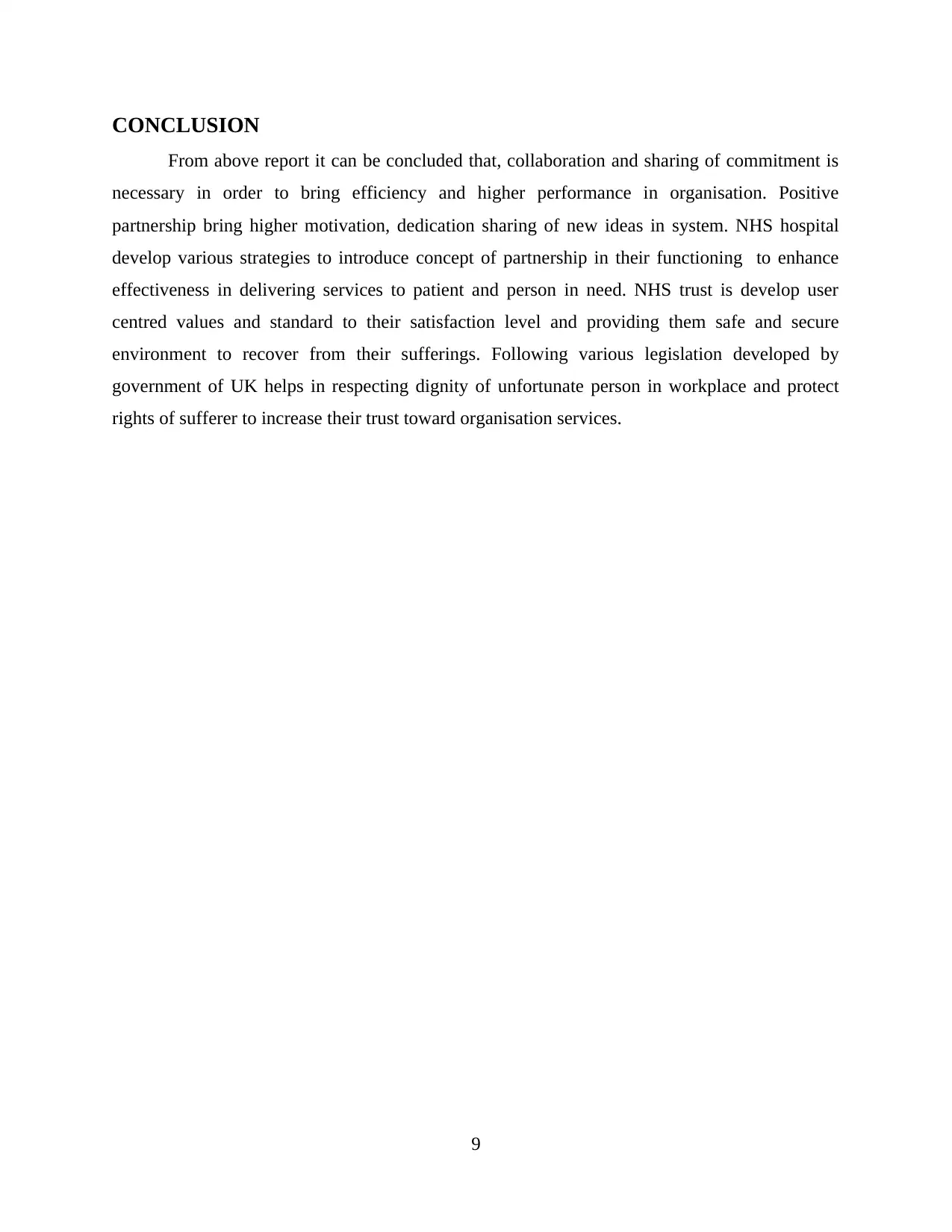
CONCLUSION
From above report it can be concluded that, collaboration and sharing of commitment is
necessary in order to bring efficiency and higher performance in organisation. Positive
partnership bring higher motivation, dedication sharing of new ideas in system. NHS hospital
develop various strategies to introduce concept of partnership in their functioning to enhance
effectiveness in delivering services to patient and person in need. NHS trust is develop user
centred values and standard to their satisfaction level and providing them safe and secure
environment to recover from their sufferings. Following various legislation developed by
government of UK helps in respecting dignity of unfortunate person in workplace and protect
rights of sufferer to increase their trust toward organisation services.
9
From above report it can be concluded that, collaboration and sharing of commitment is
necessary in order to bring efficiency and higher performance in organisation. Positive
partnership bring higher motivation, dedication sharing of new ideas in system. NHS hospital
develop various strategies to introduce concept of partnership in their functioning to enhance
effectiveness in delivering services to patient and person in need. NHS trust is develop user
centred values and standard to their satisfaction level and providing them safe and secure
environment to recover from their sufferings. Following various legislation developed by
government of UK helps in respecting dignity of unfortunate person in workplace and protect
rights of sufferer to increase their trust toward organisation services.
9
⊘ This is a preview!⊘
Do you want full access?
Subscribe today to unlock all pages.

Trusted by 1+ million students worldwide
1 out of 13
Related Documents
Your All-in-One AI-Powered Toolkit for Academic Success.
+13062052269
info@desklib.com
Available 24*7 on WhatsApp / Email
![[object Object]](/_next/static/media/star-bottom.7253800d.svg)
Unlock your academic potential
Copyright © 2020–2025 A2Z Services. All Rights Reserved. Developed and managed by ZUCOL.





